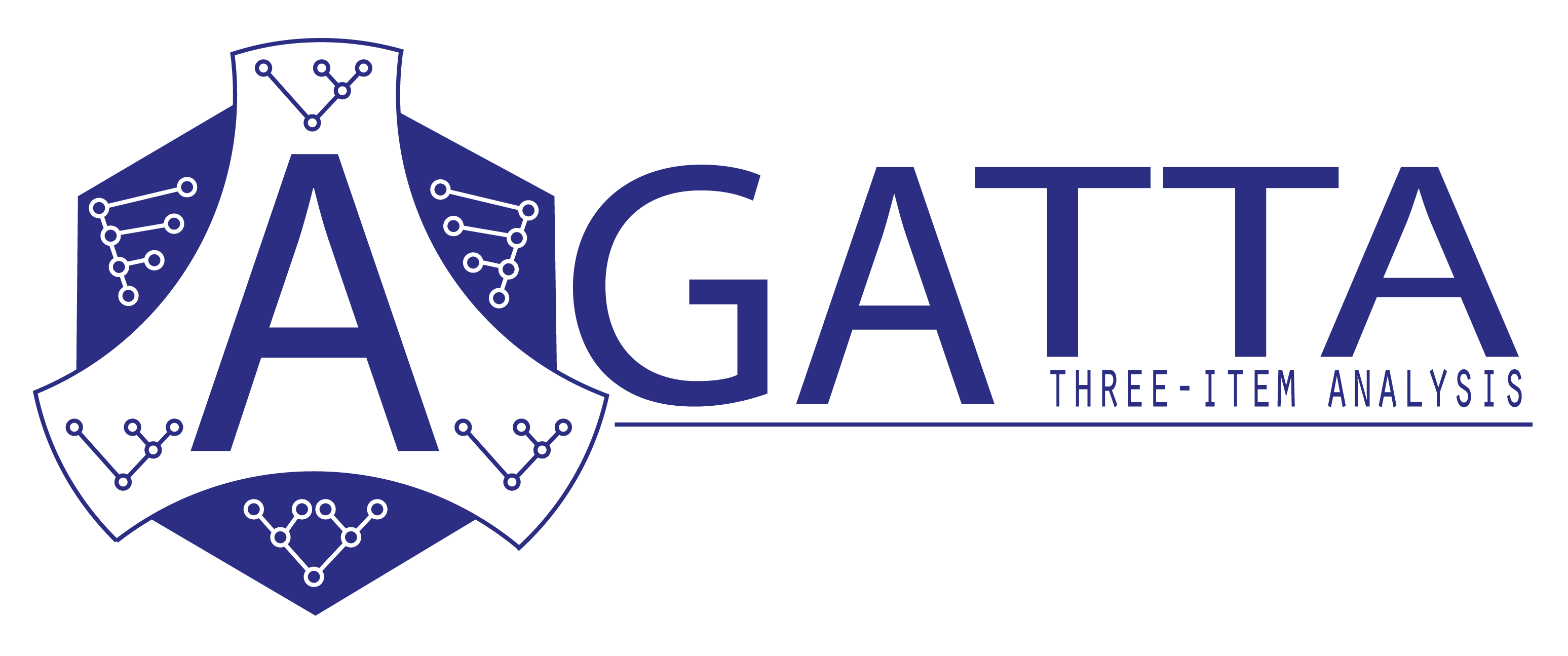Three-item analysis python package
Project description

Agatta
Presentation
Agatta is a python package for three-item analysis (Nelson and Platnick, 1991) and other rooted tree applications. Three-item analysis can be considered as a supertree method (Kitching et al., 1998). The input trees are decomposed into triplets, then coded using triplet matrix representation. Finally, a tree is estimated on the matrix using a congruence maximisation criterion. Agatta implements several triplet weighting schemes, and is technically close to the Weighted Minimum Triplet Inconsistency problem (Byrka et al. 2010), a triplet equivalent of the Weighted Minimum Quartet Inconsistency problem (Lafond and Scornavacca, 2019).
Three-item analysis was originally conceived under the cladistic theory, and can be used for reconstructing the evolutionary history of various entities. The characters (input trees) can be morphological characters coded hierarchicaly (Cao et al., 2008), rooted gene trees (with or without duplication events) or any type of evolutionary hypotheses that can be represented as rooted trees. Three-item analysis is also used in vicariance biogeography (Morrone, 2008), where phylogenies are used as input trees to build areagrams representing relationships between biogeographical areas.
Agatta is user-friendly and offers many specific features to help pre or postprocessing rooted trees. Such features include decomposing trees with duplicated tips into duplication-free subtrees, consensus methods, several triplet-based support metrics, precise tree description, character state test and mapping, and file reformating.
Installation
Agatta works on Windows, Unix/Linux and macOS.
This package requires Python version 3.7 or higher.
Agatta and all its dependencies can be installed using pip install Agatta. Detailed explanations are available in the tutorial.
The package implements a pipeline for efficient heuristic searches that requires the installation of WQFM (https://github.com/Mahim1997/wQFM-2020), TNT (http://www.lillo.org.ar/phylogeny/tnt/), or a PAUP* command-line binary (http://phylosolutions.com/paup-test).
Documentation and Support
The official repository is on GitHub
A complete tutorial is available in the GitHub Wiki.
An help for all commands is available directly using agatta help.
If you have questions, feel free to pull requests on GitHub Issues.
Usage examples
Quick analysis
Agatta allows several input trees formats like newick, nexus, nexml, or character matrix format. A generic analysis to do a three-item analysis on a collection of rooted trees stored in a file with default parameters (PAUP* heuristic search, 1000 replicates, triplets weighted using Fractional Weighting; Rineau et al. 2021) would be:
agatta analysis <file> --software=paup --softpath=/path/to/paup-executable
The --softpath and --software=paup flags are required.
Cladistic biogeography analysis
To run a three-area analysis on a collection of rooted phylogenies stored in newick format in a file with default parameters (PAUP* heuristic search, 1000 replicates, triplets weighted according to Rineau et al. (2021), Multiple-Area Single Taxa automatically removed, repetitions managed using Triplet Maximisation Subtrees algorithm):
agatta analysis <file> --software=paup --softpath=/path/to/paup-executable --rosetta=<mapfile>
This line is identical as for quick analysis plus a mapping file () in csv with two columns to give the correspondance between taxa (left column) and areas (right column).
License
The code is currently licensed under the GNU General Public License version 3.
Citation
When using Agatta, please cite us (temporarily) as
Rineau, V., Zaharias, P. (2023) Agatta (Version 0.8.0) [Software]. Github. https://github.com/vrineau/Agatta.
References
- Byrka, J., Guillemot, S., & Jansson, J. (2010). New results on optimizing rooted triplets consistency. Discrete Applied Mathematics, 158(11), 1136-1147.
- Cao, N., Zaragüeta i Bagils, R., & Vignes-Lebbe, R. (2007). Hierarchical representation of hypotheses of homology. Geodiversitas, 29(1), 5-15.
- Kitching, I. J., Forey, P., Humphries, C., & Williams, D. (1998). Cladistics: the theory and practice of parsimony analysis. Oxford University Press.
- Lafond, M., & Scornavacca, C. (2019). On the weighted quartet consensus problem. Theoretical Computer Science, 769, 1-17.
- Morrone, J. J. (2008). Evolutionary biogeography: an integrative approach with case studies. Columbia University Press.
- Nelson, G., & Platnick, N. I. (1991). Three‐taxon statements: a more precise use of parsimony? Cladistics, 7(4), 351-366.
- Rineau, V., Zaragüeta i Bagils, R., & Bardin, J. (2021). Information content of trees: three-taxon statements, inference rules and dependency. Biological Journal of the Linnean Society, 133(4), 1152-1170.
Graphic chart by Malcolm T Sanders
Project details
Release history Release notifications | RSS feed
Download files
Download the file for your platform. If you're not sure which to choose, learn more about installing packages.












